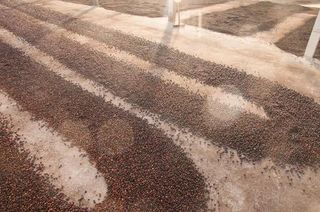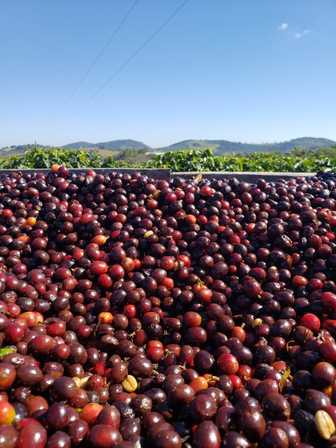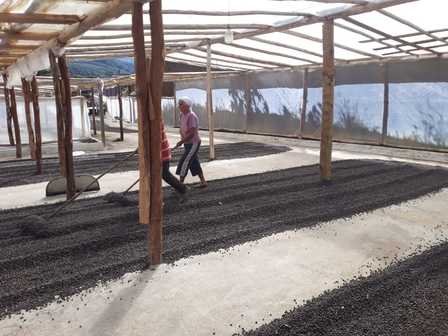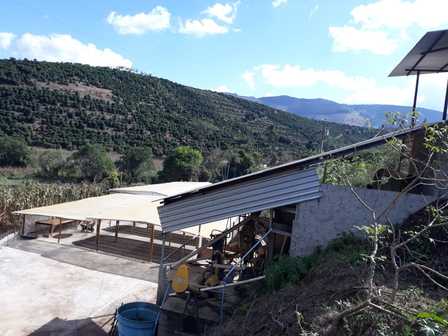September 2019
Feature #10
We first featured Society Coffee back in December 2018 with a coffee from Ethiopia, which remains a personal favorite. When the Society team contacted us mid 2019 with the possibility of another collaboration, we jumped at the chance. Spoilt for choice of coffees with inspirational stories and tracability was no surprise, it was apparent from our first conversation with David that Society really are in it from seed, to cup. Read about that collaboration here.
September was another month of firsts. Our first time having a returning roaster, our first coffee from Brazil and our first time sharing a coffee that became known as Onofre's little yellow by producers in the micro region of Forquilha do Rio, Brazil.
During September we explored:
The Challenge:
Drying in the rain. A concept not much appreciated by the
producers of Forquilha do Rio and a challenge that they have
had to overcome. While most producers at lower altitudes
had finished their harvest around October, producers such as
Onofre Lacerda were facing late harvests and deteriorating
weather in which to dry their harvest. A harvest delayed by
the slow maturing cherries (maturing as late as November /
December) now known locally as the flowers of March.
In addition to late harvests, producers couldn’t identify
any quality improvements to production until an Agronomist
presented a varietal that promised faster maturation.
In 1997 Onofre obtained 2000 seedlings and distributed
them throughout his estates.
The first harvest was made in mid-June 2000 by Onofre
And his family with pleasing results attributed to the faster
and more consistent maturation. The same year more
seedlings were cultivated and word got around with several
local coffee producers planting Onofre’s little yellow as it
became known.
By the time the region became known for producing high
quality coffees, it attracted buyers who selected lots from
many different producers. One of whom had a special
appreciation for the varietal with a “bluish” colouration and
high sweet notes, calling it Yellow Caparao.
The Varietal:
According to AIC (Agronomic Institute of Campinas, a centre that gathers information on coffee cultivation, species, production, genome and other date since 1920) Yellow Caparao was one of hundreds of lines sent to researchers at the former Brazilian coffee institute (IBC) in Caratinga, Minas Gerais. From this municipality the varietal went to a nursery in Manhumrim in the Caparao region, a nursery that unfortunately no longer exists. Traceable characteristics (up to what can be traced) of Yellow Caparao indicate it is a material grown outside of this region and its unique qualities do not resemble any other varietal currently cultivated. In 2017 AIC geneticist Herculano Pena Medina Filho, in partnership with the Lacerda family, created an experimental field of varietals on Onofre’s property. The heterogeneous material is being genetically purified to homogenize and meet standardisation criteria for both producers and consumers of Yellow Caparao. The first results from this experiment are being collected in this years crop, a harvest from an average of 1400 M.A.S.L from here you can see the mountains of the Caparao National park and the entire valley where the varietal that will enter the history of Brazilian coffee cultivation will be dried.
The Region:
Coffee plantations, flowers and colourful houses as far as
the eye can see. Preserved forests, coffee drying patios,
cheerful people and clear pure water.
Situated on the border of Esprito Santo and Minas Gerais
states is the micro region of Forquilha do Rio.
A region near the well-known for its high altitude, proximity
to Caparao National Park, of and location of Pico da
Bandeira, Brazil’s third highest peak.
This region became known in recent years as local
producers were getting recognition at regional and national
competitions, this bringing them to the attention of the
coffee world.
It is estimated that today there is in excess of .100,000
planted coffee trees in the micro valley of “Forquilha do Rio.”
The Yellow Caparao plays the main role with labour
distribution and harvest logistics generating local income.
The beans start to ripen at the end of May and the harvest
Begins. Catuai, the most common varietal grown in the
region ripens later than its Yellow Caparao counterpart,
meaning when the Catuai is ready to be harvested, the
Caparao has already been laid out on patios to dry and sold
to market. This provides financial support to producers who
remain active in the field until the end of the year.
Many local producers grow both varietals on their farms,
This helps to optimise family labour and the logistics of the
drying patios, but most importantly the gradual harvest
results in more coffee bags sold to market.
Tasting notes:
Coffee: Kaparao Reserve, Minas Gerais
Country: Brazil
Region: Serra do Caparao,
Border with Espirito Santo and Minas Gerais
Farm / Estate: Kaparao Reserve
Crop: 2018 / 2019
Altitude: 1000m – 1300m
Varietal: Yellow Caparao
Processing: Pulped Natural
Roast profile: Light
Flavour Notes: Liquor, Caramel, Citrus, and intense acidity.
Balanced clean and lingering aftertaste.
To enjoy the full story of our next release, jump over to Subscriptions to secure your place and be sure to check out our Gift Boxes too.
Thanks to 3 Brothers Coffee for the images and assistance with this collaboration.
|
© Copyright Derelict Coffee Roasters |





